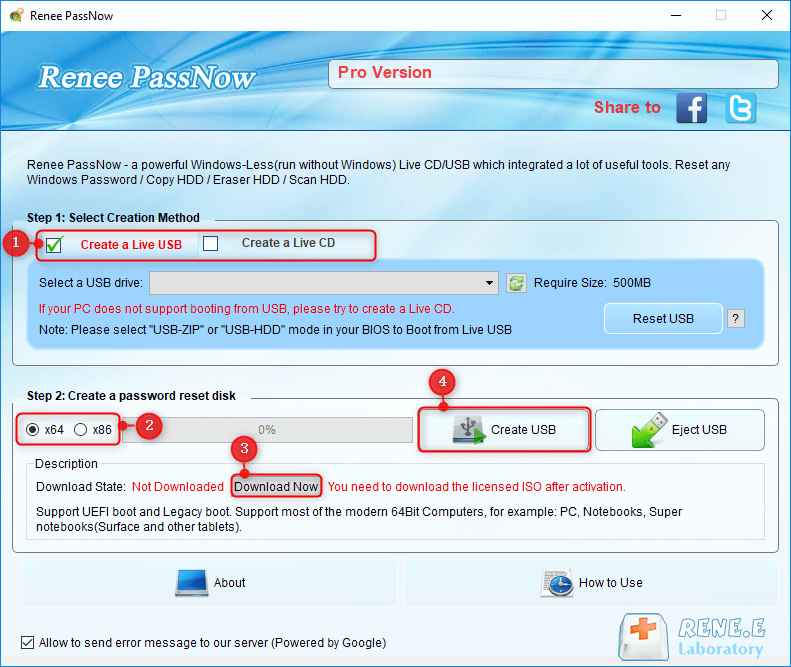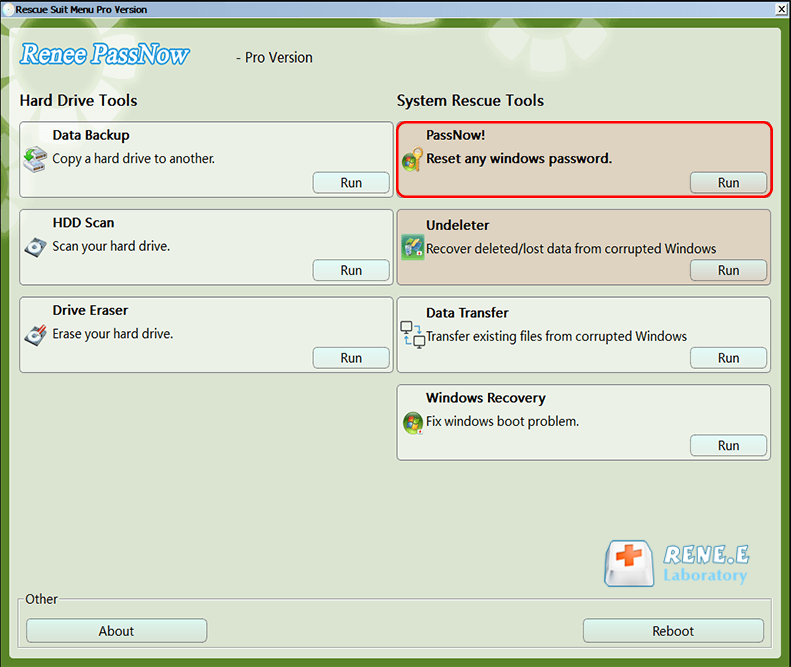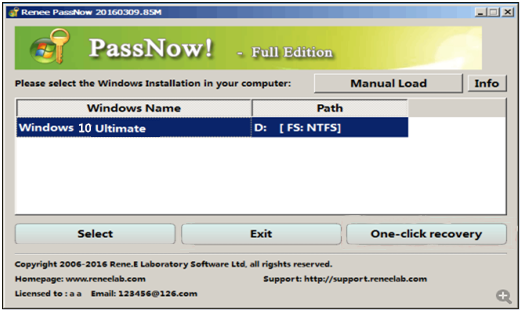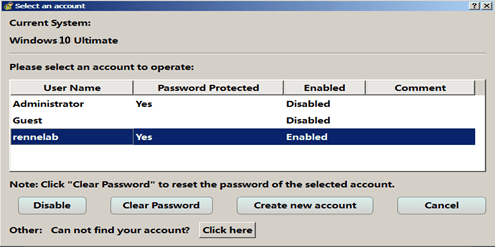Unlock Your Laptop with These 5 Easy Methods
- Home
- Support
- Tips System Rescue
- Unlock Your Laptop with These 5 Easy Methods
Summary
Unlocking your laptop just got easier with these 5 simple methods to reset your password without any hassle. From accessing the built-in administrator account to using installation media, this guide has got you covered. Make sure to keep your laptop passwords secure and try out these methods next time you forget your password.
Table of contents
| Windows Version | Enter Safe Mode Method |
|---|---|
| Windows 10 | On the Windows sign-in screen/ press and hold the Shift key while selecting Power > Restart/ then follow the on-screen instructions |
| Windows 10 | Press Windows logo key + R/ type msconfig in the Open box/ select OK/ go to the Boot tab/ and clear the Safe boot checkbox |
| Windows 8/8.1 | Access Advanced Startup Options by holding down the Shift key and selecting Restart/ or use the Settings menu to access the Advanced Startup Options menu. From there/ select Troubleshoot > Advanced Startup Options > Startup Settings > Restart. Once restarted/ select a Safe Mode option by pressing 4 or 5 (or F4 or F5) |
| Windows 7 | Use the System Configuration utility by searching for msconfig/ selecting the Boot tab/ and selecting Safe Boot under Boot options. Then restart the computer |
| Windows XP | Power on the computer and repeatedly press the F8 key until the Advanced Options Menu appears. Select Safe Mode and press Enter. Alternatively/ select Start > Run/ type msconfig/ select the Boot.INI tab/ select /SAFEBOOT under Boot Options/ and then select Restart |
Start by downloading Renee PassNow from the official website and install it on a different computer that you can access. You can choose the appropriate version based on your computer’s operating system.

Remove Windows Login Password 3 steps for whole password remove process.
Recover the files Recover the deleted files without Windows system.
Transfer the data Transfer the important files of the computer with system.
Multifuctional Data transfer, data recovery, bootable problem recovery can be run without system.
Highly compatible Windows 11/10/8.1/8/7/XP/Vista. UEFI boot.
Remove Login Password Support Windows 11/10/8.1/8/7/XP/Vista. UEFI boot.
Recover the files Recover the deleted files without Windows system.
Transfer the data Transfer the important files of the computer with system.
Launch Renee PassNow and insert a USB flash drive or blank CD/DVD into the computer. Select the option to create a bootable media. Follow the on-screen instructions to complete the process.

Insert the bootable USB or CD/DVD into the locked Windows computer. Restart the computer and enter the BIOS settings by pressing the appropriate key (usually F2 or Delete). Configure the boot order to prioritize the bootable media.
| Server Type | Enter boot menu method |
|---|---|
| DELL | Press the F12 key repeatedly before the Dell logo appears on the screen. |
| HP | Press the F9 key multiple times when the HP logo is displayed. |
| BIOS Name | Enter boot menu method |
|---|---|
| ASRock | DEL or F2 |
| ASUS | DEL or F2 for PCs/ DEL or F2 for Motherboards |
| Acer | DEL or F2 |
| Dell | F12 or F2 |
| ECS | DEL |
| Gigabyte / Aorus | DEL or F2 |
| Lenovo (Consumer Laptops) | F2 or Fn + F2 |
| Lenovo (Desktops) | F1 |
| Lenovo (ThinkPads) | Enter then F1 |
| MSI | DEL |
| Microsoft Surface Tablets | Press and hold Power and Volume Up buttons |
| Origin PC | F2 |
| Samsung | F2 |
| Toshiba | F2 |
| Zotac | DEL |
| HP | Esc/ F9 for `Boot Menu`/ Esc/ F10/ Storage tab/ Boot Order/ Legacy Boot Sources |
| INTEL | F10 |

After successfully booting from the bootable media, Renee PassNow will load. Select “PassNow!” function after booting from the new created Windows password reset disk.

Choose the user account for which you want to reset the password. Then, click on the “Clear Password” button. Renee PassNow will remove or reset the password for the selected user account.


Once the password is reset, remove the bootable media from the PC and restart the computer. You will now be able to log in to Windows Account without a password.
- Can reset laptop password without data loss
- Can convert Microsoft account to Local account
- Provides other features like creating a backup and wiping out data
Cons:
- Requires a separate computer with internet access and a USB drive
- Paid version required for additional features
| Windows Version | Download Link | Requirement |
|---|---|---|
| Windows 7 | https://learn.microsoft.com/lifecycle/products/windows-7 | PC with a working Internet connection/ a blank USB flash drive or DVD with at least 8 GB of available storage space/ a product key |
| Windows 8/8.1 | https://www.microsoft.com/software-download/windows8 | Same to above |
| Windows 10 | https://www.microsoft.com/software-download/windows10 | Same to above |
| Windows 11 | https://www.microsoft.com/software-download/windows11 | Same to above |
copy c:\windows\system32\sethc.exe c:\
copy c:\windows\system32\cmd.exe c:\windows\system32\sethc.exe
net user "username" *
- Relatively simple and effective method
- Does not require the old password
- Can be used when you do not have access to the old password
Cons:
- Requires technical knowledge and preparation beforehand
- May cause data loss if not backed up properly
- Alternative methods like password reset disk or third-party software are recommended
| Brand Name | How to Enter Recovery Partition |
|---|---|
| Dell | Restart the laptop and repeatedly press the F8 key until the Advanced Boot Options menu appears. Select ‘Repair Your Computer’ and choose the language preferences. Then/ click on ‘Dell Factory Image Restore’ to initiate the factory reset process. |
| Asus | Turn off the device and then press and hold the F9 key while turning it back on. Keep holding the F9 key until the Asus Recovery partition is launched. Select the language and click ‘Next.’ Then/ choose the ‘Restore Factory Settings’ option and follow the prompts to complete the factory reset. |
| Lenovo ThinkPad | Turn off the device and press the F11 key repeatedly during startup. This will open the Lenovo Recovery partition. Choose the ‘Restore Your System’ option and click ‘Next.’ Follow the on-screen instructions to proceed with the factory reset process. |
| Acer | Turn off the device and then press and hold the Alt and F10 keys simultaneously while turning it back on. This will launch the Acer Recovery Management utility. Select ‘Restore System to Factory Default’ and click ‘Next’ to initiate the factory reset. |
| Apple | Restart your laptop and hold down the Command and R keys until the Apple logo appears. This will boot your laptop into macOS Recovery. From there/ select ‘Disk Utility’ and click ‘Continue.’ Choose your startup disk and click ‘Erase.’ Once the erase process is complete/ exit Disk Utility and select ‘Reinstall macOS’ to perform a factory reset. |
| MSI | Turn off the laptop and press the F3 key multiple times during startup. This will bring up the MSI Recovery Manager. Choose the ‘System Recovery’ option and follow the on-screen instructions to initiate the factory reset. |
| Surface | Shut down the device and then press and hold the Volume Up button. While still holding the Volume Up button/ press the Power button to turn on the laptop. Release the Volume Up button when the Surface logo appears. Select ‘Troubleshoot’ and then ‘Reset this PC’ to perform the factory reset. |
| HP | Power off the laptop and press the F11 key repeatedly during startup. This will open the HP Recovery Manager. Select ‘System Recovery’ and follow the prompts to begin the factory reset process. |
| Advent | Restart your computer and immediately start tapping the F8 or F10 key. This will bring up the recovery tools on your hard drive. Follow the on-screen prompts to restore your computer to its original factory settings. |
| Method Name | advantages | limitations | data loss risks |
|---|---|---|---|
| Removing the password entirely by accessing the built-in administrator account | Resetting laptop without needing a password/ regain access to laptop | Build-in administrator must be enabled| Requires starting laptop in Safe Mode/ recommended to set a new password for security | - |
| Using Renee PassNow to reset the laptop password/ then factory reset the laptop | Resetting laptop password/ does not require technical knowledge | - | - |
| Using Installation Media to Reset Laptop Password | Resetting laptop password | May require technical knowledge and preparation/ potential data loss if not backed up | Potential data loss if not backed up |
| Utilizing Recovery Partitions on the Laptop to Reset the Password | Factory resetting laptop/ restoring to factory settings | May erase all personal data and settings/ need to back up important files | May erase all personal data and settings |
Relate Links :
Unlock Your Acer Laptop: Factory Reset Without Password
10-10-2023
Amanda J. Brook : Forgot your Acer laptop password? Don't worry, you can still factory reset it without the need for a...
Removing Windows Password: A Guide to Factory Resetting Your Laptop without password
10-10-2023
Ashley S. Miller : Having trouble accessing your laptop due to a lost or forgotten password? Don't worry, there are easy ways...
Resetting Your HP Laptop Password Without a Disk - A Comprehensive Guide
27-09-2023
Ashley S. Miller : In this article, we will provide you with a detailed tutorial on how to reset your HP laptop...
Resetting Your Dell Laptop: Easy Steps to Factory Reset without Password
03-09-2023
Ashley S. Miller : Discover how to factory reset your Dell laptop without a password using our comprehensive guide.




